- Home >> Solution >> Appliances >> car appliances
Car air purifier solution
With the rapid development of society, the number of cars in China continues to grow. According to statistics, the total sales of cars in China reached 28.8789 million in 2017. People rely more and more on cars as a means of transportation, and people spend more and more time in cars. Research on pollutants and purification methods in cars has also received more and more attention.
Pollutants in the car generally include toxic gases such as formaldehyde and xylene emitted from car interior parts, part of the car exhaust that enters the car, dust, PM2.5 and other harmful particles that enter the car in haze weather, and bacteria in the car. Due to the complex types of pollutants and the mixed effects of factors inside and outside the car, it is difficult to obtain a healthy car environment simply by opening windows for ventilation or air conditioning.
An air purifier is an electrical appliance that has a certain ability to remove one or more pollutants such as particulate matter, gaseous pollutants, and microorganisms in the air. More and more OEMs choose to configure vehicle-mounted air purifiers, through air filtration, negative ions, plasma, etc. The technology purifies the air inside the car and improves the quality of the environment inside the car.
1. Design principles and requirements of vehicle air purifiers
1.1 Design Principles of Car Air Purifiers
Due to the relatively small space in the car and the limited volume of the air purifier, the structure and performance need to be considered comprehensively during the development process. The design principles of the air purifier are:
(1) Stability and reliability: Stability and reliability are prerequisites for auto parts. In the development and actual use of air purifiers, stable and reliable technical solutions need to be given priority.
(2) Standardization and normativeness: International, national and industry standards shall be adopted first, and the design shall be standardized as much as possible.
(3) Practicability and advancement: On the basis of adopting mature and stable technology, continuous innovation reflects the advancement of products.
(4) Economy: The purifier is reasonably configured and has a good cost performance.
1.2 Vehicle Air Purifier Requirements
The GB/T 18801-2015 standard includes air purifiers for passenger cars, and stipulates the requirements for noise, pollutant removal, and standby power of air purifiers. However, the requirements for auto parts are higher than those for general products. Corresponding supplements are made for the environment in which passenger cars are used, such as appearance, environmental reliability, electromagnetic compatibility, etc.
1.2.1 Appearance: Customers have higher and higher requirements for automobile quality, and OEMs have very strict requirements for the appearance quality of parts. According to the operation and assembly state of the parts on the vehicle, A, B, C, and D areas are distinguished. The parts that can be seen clearly in the operating state and normal posture belong to the most critical A-level area. The air purifier needs to be operated and , its appearance surface is required according to the A-level regional standard: (1) The surface is smooth and flat, and no defects (such as burrs, wrinkles, cracks, deformation, etc.) that can be seen with the naked eye; (2) The color and pattern of the purifier surface should be consistent with The swatches or swatches defined by the styling are consistent. The skin texture is clear, the color is uniform, the skin texture type, texture direction, texture depth and skin texture range are all consistent with the definition requirements; (3) The gap surface difference of the purifier should meet the gap surface difference requirements of the vehicle interior parts, and the key parts should have Relevant gauges are monitored.
1.2.2 Purification function: GB/T 18801 defines particulate matter in the air, gaseous pollutants, and microorganisms as three target pollutants, but the purification capacity of pollutants is not clearly stipulated. According to the purification function requirements are as follows: (1) PM2. 5 Purification efficiency; (2) Clean air volume (CADR) of solid particles; (3) Toluene, xylene, benzene, formaldehyde, ethylbenzene removal rate; (4) Sterilization rate; (5) Ozone concentration and TVOC concentration.
1.2.3 Environmental reliability: Facing the constantly changing external environment during vehicle driving, it needs to withstand the test of harsh environment, so the product needs good environmental reliability. When designing a purifier, the environmental factors that need to be considered include climate and environmental conditions (temperature, humidity, etc.), vehicle use conditions, power supply voltage, product life cycle (production, shipment, operation, storage, vehicle maintenance and repair, etc.), The installation position on the vehicle, etc., the environmental reliability requirements are as follows: (1) The purifier cannot interfere with the surrounding electronic parts and the whole vehicle; (2) The purifier should be able to resist external electromagnetic field interference; (3) Can resist the ambient temperature , humidity, vibration frequency, power supply voltage and other changes; (4) have production, shipment, operation, storage, maintenance and repair reliability.
1.2.4 Special requirements: Compared with other electronic products, vehicle-mounted air purifiers have certain special requirements: (1) Volatilization of organic matter: meet the limitation conditions of 8 substances (pentaphenyltrialdehyde) of OEMs; (2) Odor: Meet the odor requirements; (3) Prohibited and restricted substances: meet the limit value requirements of 6 prohibited and restricted substances (lead, mercury, hexavalent chromium, cadmium, polybrominated biphenyls, and polybrominated diphenyl ethers).
2. Design points of car air purifier
2.1 Vehicle Air Purifier Module Division
Dividing the vehicle air purifier into modules can optimize the development process and reduce development costs. The vehicle-mounted air purifier should have air purification function, data acquisition function and human-computer interaction function. At the same time, it needs a control module and a power circuit to ensure the operation of the entire system. The system module is shown in Fig. 1.
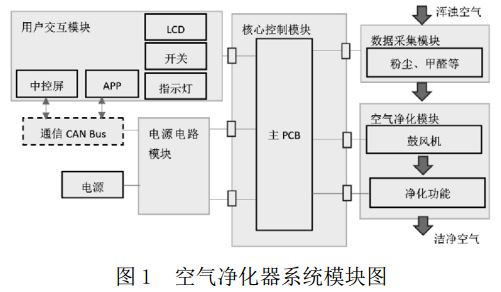
2.2 Purification method selection
At present, the commonly used purification technologies include mechanical filtration, negative ion, plasma, ozone and photocatalyst, etc. The principles, advantages and disadvantages of each method are shown in Table 1. These air purification methods have their own advantages and disadvantages. When designing and developing, it is usually necessary to combine several technologies in order to better improve the air quality in the car.
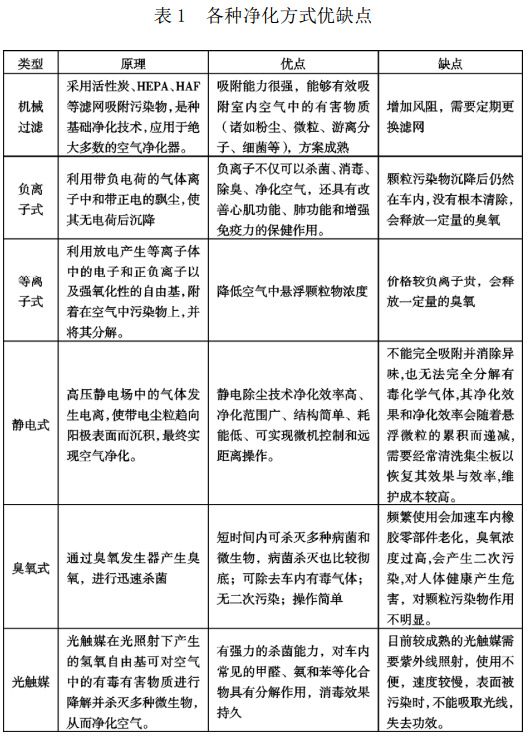
2.3 Human-computer interaction design
With the development of intelligent automobiles, automobiles are not only a means of transportation, but also a way of life. This also requires more intelligent auto parts. It has evolved to interact with the mobile APP through the central control screen. The car purifier and the central control are interconnected through the CAN network, which can realize display, operation and other functions. The car purifier transmits the signal to the TBOX through the CAN line, and the user can remotely control the air purifier through the mobile phone APP, and the real-time display of the air quality in the car is displayed on the mobile phone APP. Table 2 shows the main interaction modes of the car purifier:
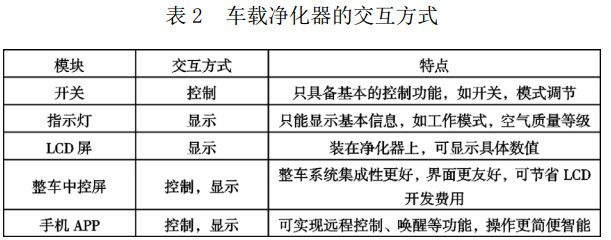
When designing in an interactive way, the design of the interface is very important, and it needs to be planned through layout, color and details. In the development of vehicle models, the central control screen, mobile phone APP and air purifier are usually developed by different departments. It needs to be planned in the whole vehicle project development process to form a consistent style of each interface.
Combined with the characteristics of the purifier, fresh tones such as blue and green in the interface express good air quality, while impactful tones such as yellow, red and purple express poor air quality. Bright and pure colors are in the visual hierarchy Colors with lower lightness and purity are lower in the visual hierarchy.
2.4 Design of power-taking method
Car air purifiers are divided into movable type and fixed type. The fixed type takes power in a relatively simple way, and the wiring harness can be designed inside the interior parts. The movable type is generally a central armrest type purifier. There are three main ways to get power:
(1) Reserve a wire harness hole directly on the purifier, and the wire harness is routed through open wires, and at the same time protect the power wire with a telescopic tube, as shown in Figure 3. The power cord of this method should be pulled out together with the telescopic tube. The advantage is good reliability and simple structure. It only needs to open the wiring harness hole on the purifier and the armrest box, and the data change is small. The disadvantage is that when the purifier needs to be switched, the telescopic tube can be removed. Visibly found, affecting the appearance. When designing this scheme, it is necessary to consider the compression ratio of the telescopic tube and reserve enough space in the armrest box.
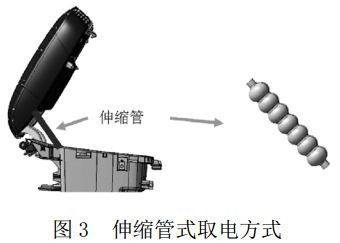
(2) Take power along the hinge position, and add a plastic sheath outside the metal hinge, as shown in Figure 4. The advantage of this method is that it is highly concealed and the overall shape is beautiful, and it is the most widely used method. The disadvantage is that the wires are routed along the hinge position, and plastic parts are added to the outside of the hinge. The structure is more complicated, and the larger wire harness cannot pass through. It is necessary to reserve enough space at the beginning of the design, and when the armrest is opened and closed many times, the power cord It is easy to wear and tear. When designing, it is necessary to restrain the wire harness to reduce wear, and to check the motion of the wire harness, and avoid the parts around the wire harness.
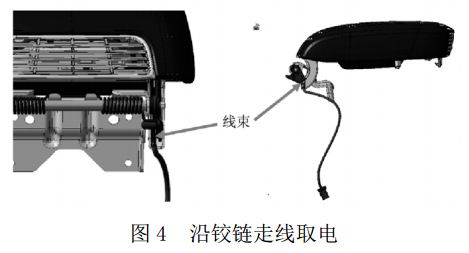
(3) Contact type power supply. As shown in Figure 5, the advantage of this method is that it is more concealed, the overall shape is beautiful and fashionable, and it has a strong sense of technology. The application of the vehicle model reduces the cost, and the contact switch combines the protection switch and the power supply, which is convenient for assembly and power supply. The disadvantage is that the contact-type power-taking is a rotating contact, and there is a slight displacement when the contact contacts, and this method can only take power. If data transmission with the outside is required, re-routing is required. The design of this scheme needs to be installed close to the hinge, so that the range of movement of the purifier is small and the misalignment of the contacts is small.
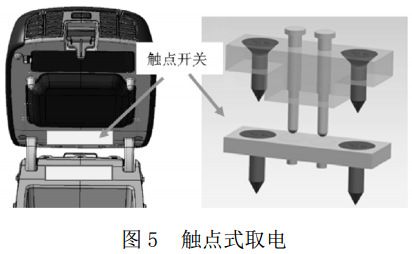
3. Design of armrest air purifier
3.1 Air Purifier Solution
A car model plans to develop an armrest-mounted vehicle-mounted air purifier. According to the input of development instructions, shape definition, and user demand identification, and comprehensively consider reliability and economy, the following design schemes are adopted for each module of the purifier. Figure 6 shows the purifier. Schematic.
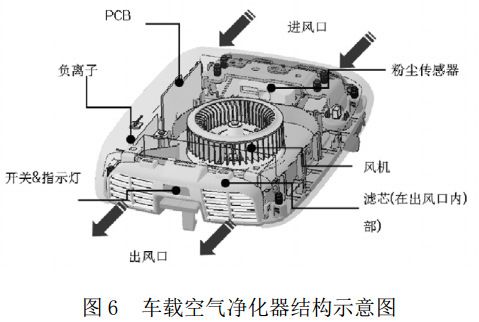
(1) The core control module uses the main PCB board to control the various parts of the air purifier, and transmit the working status to the central control panel and TBOX through CAN;
(2) For the air purification function, the multi-layer composite filter of HAF+activated carbon is selected, and the negative ion function is used for purification, which has a good treatment effect on dust, gas pollutants and germs;
(3) The user interaction function uses buttons with indicator lights to control the purifier, and outputs the air quality through the central control screen and mobile APP.
(4) The data acquisition module uses a PM2.5 sensor to detect PM2.5 in the vehicle room and sends the data to the Main PCB.
3.2 Structure design and optimization
In order to ensure that the air purifier needs to have good environmental reliability and performance, CAE and test methods are used to verify the structure during development, and corresponding enhancements are made to problematic parts. The following points were carried out during the structural design of the car air purifier:
(1) For the strength of filter screen cover, handle, hinge and other movable parts and parts in contact with other boundaries, add appropriate ribs or increase wall thickness. In the CAE analysis of the drop test, the strength of the hinge neck is weak. This problem is solved by increasing the thickness of the neck, which increases from 16.5mm to 23.5mm.
(2) Appropriate shock-absorbing pads or protective pads should be added to the parts where the filter, fan, sensor and other components are in contact with other boundaries to reduce the abnormal noise caused by the collision between the components during the movement of the vehicle.
(3) The filter element is frequently replaced, and a physical error-proof structure is designed. If it is not installed properly, the filter element will not be able to be installed to the bottom. Ear structures are designed on both sides to facilitate the removal of the filter element.
(4) Adopt the method of taking power along the hinge position, and design the fixed structure of the power cord to avoid wear and tear caused by frequent movement of the power cord.
3.3 Fan selection
An air purifier must have sufficient air volume to achieve qualified purification capabilities. How to design a suitable fan in a limited space usually requires the use of CFD technology to optimize the fan.
As the environmental problems in the car are getting more and more attention from the public, through the development of the car air purifier, the gaseous pollutants and solid pollutants in the car can be removed, and the clean air can be brought to the car. Suffering from polluted air in the car.
The above are the details of the car air purifier solution introduced by Shenzhen Zuchuang Microelectronics Co., Ltd. for you. If you have the development and design needs of the car air purifier, you can rest assured to entrust it to us. We have rich experience in customizing and developing electronic products. We can evaluate the development cycle and IC price as soon as possible, and can also calculate the PCBA quotation. We are a number of chip agents at home and abroad: Songhan, Yingguang, Jieli, Ankai, Quanzhi, realtek, with MCU, voice IC, Bluetooth IC and module, wifi module. Our development capabilities cover PCB design, single-chip microcomputer development, Bluetooth technology development, software customization development, APP customization development, WeChat official account development and other hardware and software design. It can also undertake the research and development of smart electronic products, the design of household appliances, the development of beauty equipment, the development of Internet of Things applications, the design of smart home solutions, the development of TWS earphones, the development of Bluetooth earphone speakers, the development of children's toys, and the development of electronic education products.
- TOP
